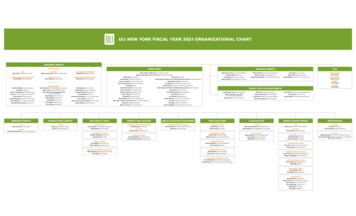
Transcription
1M/s. K. A. PanditConsultants & ActuariesDipstick Survey April 2020Employee Benefits Valuations - IndiaFor more reading visit www.ka-pandit.com
Introduction2Areas coveredBackgroundResponses Actuarial valuations under IndianAccounting Standards are due forlong term employee benefits forfiscal year-end March 2020 Recentvolatilityinfinancialmarkets and business uncertaintymean companies unsure how toplace best estimate true and fairview assumptions for the actuarialprojections Dipstick survey conducted over 10days ending 7 April 2020.General Business outlook impact ofCOVID-19Actuarial assumptionsSalary Growth# 23X-Industry 70% Finance 20% HRAttritionDiscount rates80% Private sector20% Public sector
Executive Summary of FindingsBusiness OutlookSalary Growth Assumption 50%Attrition AssumptionDiscount RatesSplit view whetherA large majority ofattrition assumptionshould be modified 70% 48%feel assumptionsay business impactshould be relooked atwill be HIGHthough nearly 50% feel afeel that in the current 43% 70%feel a lowerlower rate may bevolatile times, auditorssay it will beassumption for 1 to 2suitable in the shortand regulators shouldyears followed bytermallow companies toMODERATE 40% feel it willlast 6 to 12 monthswhilst 35% felt itwill be 3 to 6 monthsterm assumption maybe suitablenumber 45% chose anattrition assumptionofresponses said 2% to5% p.a. for a shortterm assumption wasreasonable.“It should beremembered thatassumptions foractuarial valuationfor employeebenefits are to bea best estimateand are long termassumptions.”use discount ratereverting to longerHighest3Between “0% and 5%” inthe short termyields as at an earlierDisclaimer Note: These findings are illustrativedate instead of 31from an initial dipstick survey and are forMarch 2020e.g. 20 March 2020information purposes only. We plan to expandthe number of responses as the worldprogresses through the next few weeks. Acompany should liaise with its own auditor,actuary and management on the appropriateassumptions to use in its circumstances.Nothing in this document should be taken asadvice or recommendation and K A Panditaccepts no responsibility for any actions takenfrom this document.
Commentary4“It should be remembered that changes in assumptions under INDAS19 flow through the Other Comprehensive Income Statement for Post employmentbenefits. However, for Other Long Term benefits and for all benefits under AS15 (revised) the impacts flow directly through the Profit & Loss Account.Salary Growth Assumption Companies are feeling that their businesswill be impacted significantly due to thecurrent economic uncertainty and unknownimpacts of the lockdown. It is therefore notsurprising that a large portion of therespondentshaveindicatedthatassumptions in the short term should bemodified for salary growth. Assumptions, as per the accountingstandards, should be a best estimate of acompany’s expected outlook and representa true and fair view. It was, therefore, notsurprising that a large majority thought alower salary growth rate for one to twoyears followed by reverting to a higherlonger term rate was a suitable approach.This will reduce the estimated definedbenefit obligation to some extent.Attrition Assumption There was a split view as to whether theattrition assumption should be modified. It will be very difficult to predict what willhappen to voluntary attrition, especially aswe emerge out of the lockdown over thecoming weeks/months.The attritionassumption usually is not supposed toallow for retrenchments. It is common for attrition assumptions toremain relatively stable for mostbusinesses over the medium term. The impact on actuarial estimates due tochanges in attrition assumptions can varysignificantly depending on the type ofbenefit, vesting/eligibility criteria and therelationship between other relevantassumptions.Discount rate1 We have experienced a continued reduction in bond yieldsin India over the last 12 months. Our newsletter on 1 April2020 sets out more details. Companies are facing almost a 100bps reduction in somecircumstances. A reduction in discount rate means anincrease in estimated obligation. In some cases this may be offset by an increase in assetvalues, but the vast majority of companies either do nothold a separate fund against their liability or are invested ina traditional insurance fund product, that does not matchmovements in the obligation value. The accounting standards require discount rates to bechosen with reference to the market yield on Governmentbonds as at the valuation date. However, in these currentexceptional circumstances it is interesting to see that largemajority of companies would like their auditors to considera rate on another date. This may be something ICAI needsto consider, along with AP Update Volatility in the Interest Rate-March 2020.pdf
Other Insights“The impact of the current environment on long term employee benefits goes beyond the items covered in the dipstick survey.Below are some other insights and considerations for employers.” Irrespective of the current times, companies should conduct a robust and regular (24-36 months) assumption experience study toidentify trends and suitability of assumptions. Auditors are increasingly looking for scientific justification for the assumptions chosen.In fact, actuaries are bound by their professional practice standards (APS27) to comment on the general reasonableness ofassumptions if the company provides the assumption to be used. This means that actuaries too are digging deeper with respect toassumptions. Though the dipstick survey focused on the most significant assumptions, there are other assumptions that are used depending on thetype of benefit. E.g. Gold or commodity prices for long service benefits will require the price of gold. The current market prices need to beconsidered when placing a value of this benefit. Though it may not impact long term patterns, companies may need to be prepared for anomalies in their leave accumulationvaluations due to far more leaves accumulated by employees due to not taking much leave in 2020 due to the lockdown. Thecompany’s leave policy and any special treatment after the lockdown will impact the leave calculation. We have not touched on ESOPs in this survey as that is a complex topic. Needless to say, ESOP valuations are going to have tobe considered closely in terms of the impact of the current market volatility as at the year end. Provident Fund Trusts will carefully need to watch the extent to which employees utilize the temporary facility of non-refundablewithdrawals from PF balances. A sudden surge will require suitable liquidity in the Trust assets. However, a large outflow will meanlesser assets to manage the interest rate guarantees. Trustees will need to consider changes to default risks of corporate bonds theyhold too.5
6Appendix
Detailed Graphs1. How significantly will recentSalaryeventsGrowthBusiness Outlookimpact your overall business?Assumption9%48%43%3. Do you feel salaryAttritiongrowth assumptionsAssumptionshould undergo a modification for thecurrent 31 March 2020 actuarialvaluation?22%Highly5. Whatlevel of salarygrowth would youDiscountRatesfeel is appropriate in the short term?0% to 2%22%35%More than 10%4%Unsure52%ModeratelyNo726%YesMore than 5% to10%39%Slightly2. How long do you feel the effects willlast across your company?9%17%6. Do you feel attrition assumptionsshould undergo a modification for thecurrent 31 March 2020 actuarialvaluation?3 to 6 months35%6 to 12 monthsLess than 3months39%4. Do you feel that a lower short termsalary growth rate for 1-2 years, followedby reverting to longer term rate isappropriate in the current environment?More than 2% to5%More than 12months22%9%69%NoUnsureYesNo43%48%9%UnsureYes
Detailed GraphsSalary GrowthBusiness OutlookAssumption7. Do you feel that a lower short termattrition rate for 1-2 years, followedby reverting to longer term rate isappropriate in the currentenvironment?Attrition Assumption8. What level of attrition rate wouldyou feel is appropriate in the shortterm?39%30%8Discount Rates9. Given the volatile and uncertaintimes, do you feel auditors andcompanies should be instructed touse a discount rate that is based on atrading date of say 20 March 2020 ora similar date?9%44%48%22%17%22%NoUnsureYes69%0% to 5%More than 10% to25%More than 5% to10%NoUnsureYes
9About M/s. K. A. Pandit
About Us10M/s. K. A. Pandit was established on 1st February 1943, and is the oldest Actuarial Firm in India currentlyoperating from 3 offices with the help of more than 30 well trained experts and 7 qualified Actuaries. Weprovide actuarial services to a large clientele across the Globe. Some of the countries where we provideour services are Sri Lanka, Nepal, Bangladesh, Bahrain, Qatar, Oman, UAE, Singapore, Malaysia, Thailand,Maldives, China, Japan, Mauritius, Morocco, Australia, United Kingdom, United States of America etc.We are a firm based in India with Indian values but integrated with modern processes which cater toserve all businesses globally. With the major objective of client satisfaction, we provide services to a largeclientele around the world, so as to enable them to report those liabilities appropriately while meetingcompany, statutory and regulatory requirements to take an informed decision.We are one of the major players in the Indian market for Employee Benefits and also deal with LifeInsurance, Non-Life Insurance and Employee Benefits internationally. Our offerings include Asset LiabilityModelling, Scheme Design and Product Pricing, Statutory Valuations and Reporting, Risk Based CapitalValuations, Financial Conditions Reporting, Liability Adequacy Testing, Bonus Declaration, Debit/CreditCard Redeemable Points Valuations, IBNR Valuations, etc.M/s. K. A. Pandit is proud to have 75 years of heritage and experience to provide comprehensive Actuarialconsultancy services across the globe. Established as a top-tier firm and part of Abelica Global (aconsortium of actuarial firms), our actuaries and consultants come from the elite ranks of the actuarialprofession. Together with our clients, we have walked through many economic stresses, business cyclesand political upheavals.Today, with the proliferation of information, our clients rely on us to help find the right information andprofessional touch so as to enable to turn it into actionable knowledge to solve their resilient and rigidproblems with confidence. The breadth of our core competencies, innovative solutions and leadershiproles in various national and international professional organizations and forums help in providingperceptible insights that give our service its competitive edge.
Our Service LinesEmployee BenefitsEmployee benefits includevarious types of non-wagecompensation provided toemployees in addition totheir normal wages orsalaries. We take on aconsulting role to design andvalue the benefits.Life InsuranceLife insurance, in itssimplest form, is an11Non-Life InsuranceNon-Life Insurance providescompensation for lossesincurred from a specificarrangement to providefinancial event. We strive toprotection against financialprovide solutions for theselosses resulting from therisks so that you can have anpremature death of aappropriately measured riskperson.quantum that could have aneffect on your business.WE OFFER EXEMPLARY SERVICESWe are a firm based in India with Indian values but integrated with modern processes which cater to serve all businesses globally.With the major objective of client satisfaction, we provide services to a large clientele around the world, so as to enable them toreport those liabilities appropriately while meeting company, statutory and regulatory requirements.
Our Solutions for Employee Benefits12Employee BenefitsSince these benefits have to be provided by the employer they will involve anextra cost (over and above the salary paid) to the company which will have tobe accounted for in accordance with the laws and regulatory requirements ofthe country the company is based in. Hence these costs/liabilities are to bevalued and appropriately managed.FinancialInsightsPost-Employment Benefits GratuityOther Long-Term Benefits Leave Pension Long Service BenefitGovernance andAdministration Post-RetirementMedical BenefitsDesign and Provident FundShort Term Benefits Certain Leave Benefitsthat cannot be carriedforwardStructureTermination Benefits SettlementsCommunication
Our Solutions for Employee Benefits13CommunicationGovernance andAdministrationFinancialDesign andInsightsStructure Actuarial valuations underIndian and Global AccountingStandards Financial projections formanagement and fundingpurposes Cashflow projections for assetliability assessments Trend and experience analyses Advise on Retirement Trustsset up and ongoing operations Regulatory advice Trust Documentation draftingand approvals Trust accounting and secretarialsupport Project management of Trustoperationsfor appropriateness of Funding vendor selectionassumptions Trustee Training workshops Design new employee benefits Draft handbooks / rules Review existing designs to Presentation tooptimize Assess cost implications ofproposed changesemployees
14DataExperienceHappy ClientsStaff StrengthSupport40,00,000 Data Handling75 Years5000 50 365 DaysCapabilityIT security and systemsOldest Indian actuarialAnnual feedback withAccess to 9 in-houseQuick and flexibleISO 270001:2013consulting firmevery clientQualified actuariesturnaroundQuality ManagementDeep historical knowledge ofDedicated client team forMulti-disciplinary teamSystemspast regulatory developmentseach client with “Do andbringing value addition toreview” processclient queriesISO 9001:2015 certifiedMultiple CharteredAccountants in actuarial team
15 One of the world’s largest independent professional serviceorganisations providing consulting
salary growth rate for 1-2 years, followed by reverting to longer term rate is appropriate in the current environment? No Unsure Yes 22% 4% 39% 35% 5. What level of salary growth would you feel is appropriate in the short term? 0% to 2% More than 10% More than 2% to 5% More than 5% to 10% 43% 9% 48% 6. Do you feel attrition assumptions


